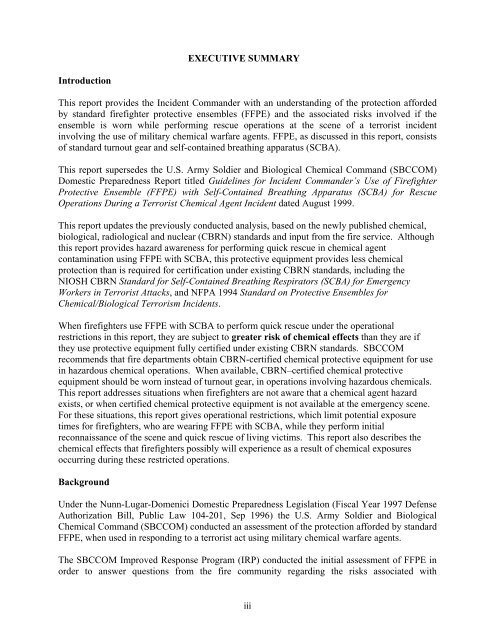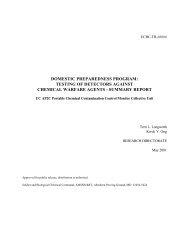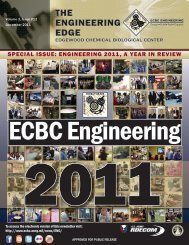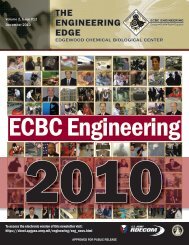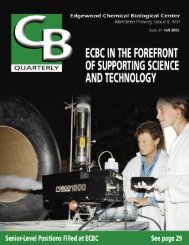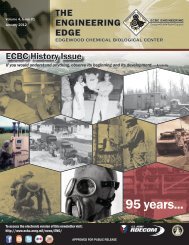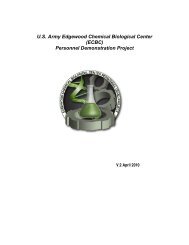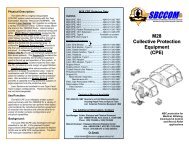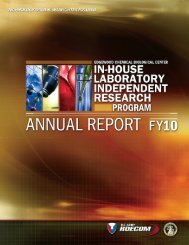(FFPE) with Self-Contained Breathing Apparatus (SCBA) for Rescue
(FFPE) with Self-Contained Breathing Apparatus (SCBA) for Rescue
(FFPE) with Self-Contained Breathing Apparatus (SCBA) for Rescue
You also want an ePaper? Increase the reach of your titles
YUMPU automatically turns print PDFs into web optimized ePapers that Google loves.
EXECUTIVE SUMMARY<br />
Introduction<br />
This report provides the Incident Commander <strong>with</strong> an understanding of the protection af<strong>for</strong>ded<br />
by standard firefighter protective ensembles (<strong>FFPE</strong>) and the associated risks involved if the<br />
ensemble is worn while per<strong>for</strong>ming rescue operations at the scene of a terrorist incident<br />
involving the use of military chemical warfare agents. <strong>FFPE</strong>, as discussed in this report, consists<br />
of standard turnout gear and self-contained breathing apparatus (<strong>SCBA</strong>).<br />
This report supersedes the U.S. Army Soldier and Biological Chemical Command (SBCCOM)<br />
Domestic Preparedness Report titled Guidelines <strong>for</strong> Incident Commander’s Use of Firefighter<br />
Protective Ensemble (<strong>FFPE</strong>) <strong>with</strong> <strong>Self</strong>-<strong>Contained</strong> <strong>Breathing</strong> <strong>Apparatus</strong> (<strong>SCBA</strong>) <strong>for</strong> <strong>Rescue</strong><br />
Operations During a Terrorist Chemical Agent Incident dated August 1999.<br />
This report updates the previously conducted analysis, based on the newly published chemical,<br />
biological, radiological and nuclear (CBRN) standards and input from the fire service. Although<br />
this report provides hazard awareness <strong>for</strong> per<strong>for</strong>ming quick rescue in chemical agent<br />
contamination using <strong>FFPE</strong> <strong>with</strong> <strong>SCBA</strong>, this protective equipment provides less chemical<br />
protection than is required <strong>for</strong> certification under existing CBRN standards, including the<br />
NIOSH CBRN Standard <strong>for</strong> <strong>Self</strong>-<strong>Contained</strong> <strong>Breathing</strong> Respirators (<strong>SCBA</strong>) <strong>for</strong> Emergency<br />
Workers in Terrorist Attacks, and NFPA 1994 Standard on Protective Ensembles <strong>for</strong><br />
Chemical/Biological Terrorism Incidents.<br />
When firefighters use <strong>FFPE</strong> <strong>with</strong> <strong>SCBA</strong> to per<strong>for</strong>m quick rescue under the operational<br />
restrictions in this report, they are subject to greater risk of chemical effects than they are if<br />
they use protective equipment fully certified under existing CBRN standards. SBCCOM<br />
recommends that fire departments obtain CBRN-certified chemical protective equipment <strong>for</strong> use<br />
in hazardous chemical operations. When available, CBRN–certified chemical protective<br />
equipment should be worn instead of turnout gear, in operations involving hazardous chemicals.<br />
This report addresses situations when firefighters are not aware that a chemical agent hazard<br />
exists, or when certified chemical protective equipment is not available at the emergency scene.<br />
For these situations, this report gives operational restrictions, which limit potential exposure<br />
times <strong>for</strong> firefighters, who are wearing <strong>FFPE</strong> <strong>with</strong> <strong>SCBA</strong>, while they per<strong>for</strong>m initial<br />
reconnaissance of the scene and quick rescue of living victims. This report also describes the<br />
chemical effects that firefighters possibly will experience as a result of chemical exposures<br />
occurring during these restricted operations.<br />
Background<br />
Under the Nunn-Lugar-Domenici Domestic Preparedness Legislation (Fiscal Year 1997 Defense<br />
Authorization Bill, Public Law 104-201, Sep 1996) the U.S. Army Soldier and Biological<br />
Chemical Command (SBCCOM) conducted an assessment of the protection af<strong>for</strong>ded by standard<br />
<strong>FFPE</strong>, when used in responding to a terrorist act using military chemical warfare agents.<br />
The SBCCOM Improved Response Program (IRP) conducted the initial assessment of <strong>FFPE</strong> in<br />
order to answer questions from the fire community regarding the risks associated <strong>with</strong><br />
iii


